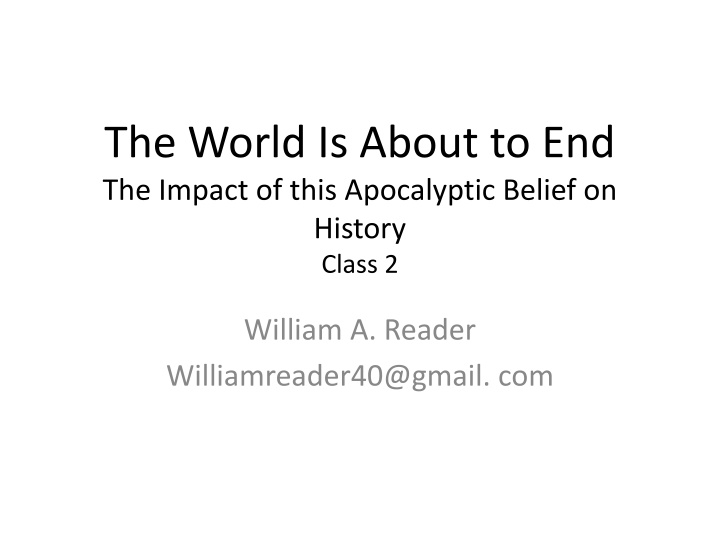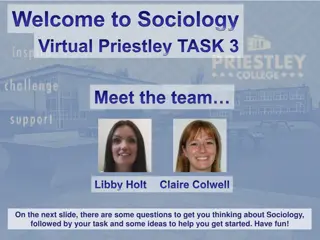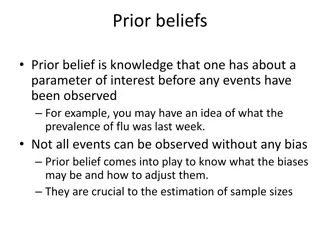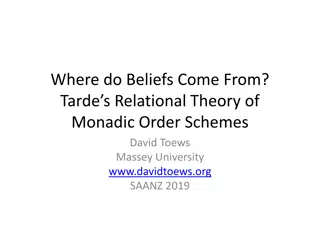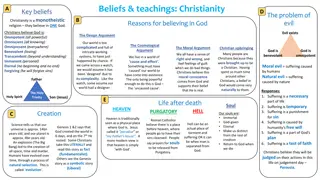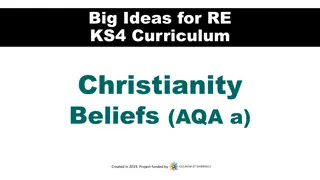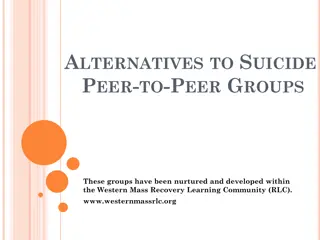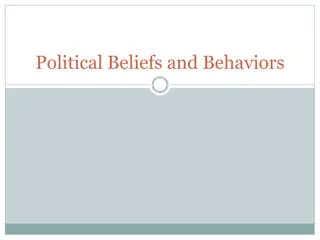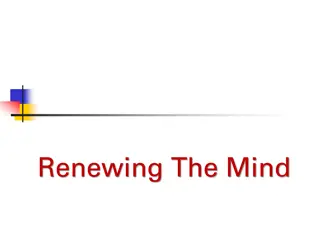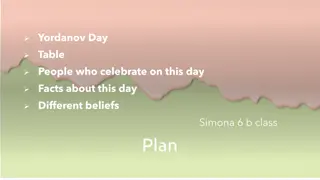The Impact of Apocalyptic Beliefs Throughout History
Explore the historical impact of apocalyptic beliefs on society, from reactions to delayed Second Coming to the origins of the Antichrist concept. Delve into how these beliefs influenced history and shaped different interpretations over time.
Download Presentation

Please find below an Image/Link to download the presentation.
The content on the website is provided AS IS for your information and personal use only. It may not be sold, licensed, or shared on other websites without obtaining consent from the author.If you encounter any issues during the download, it is possible that the publisher has removed the file from their server.
You are allowed to download the files provided on this website for personal or commercial use, subject to the condition that they are used lawfully. All files are the property of their respective owners.
The content on the website is provided AS IS for your information and personal use only. It may not be sold, licensed, or shared on other websites without obtaining consent from the author.
E N D
Presentation Transcript
The World Is About to End The Impact of this Apocalyptic Belief on History Class 2 William A. Reader Williamreader40@gmail. com
What We Will Cover Today Reaction to the delayed Second Coming The Antichrist Origins of the concept Joachim of Fiore How belief in this entity impacted history John Nelson Darby The Rapture The Role of the Jews in the End Times Hal Lindsay
He Didnt Come As decades and then centuries passed, the Church had to confront the fact that Second Coming had not occurred This was done in three ways In the later books of the New Testament by pointing out certain prerequisites that had to occur beforehand and that no one knows the day or the hour The Church Fathers by adopting an allegorical view of Scripture and contending that the Millennium began with the advent of Christ Augustine by interpreting history as a struggle between two cities the city of God and the city of Man that will continue until the Last Judgment
The Decline of Apocalyptic Millennialism What St. Augustine and the Church Fathers did was distance Catholic thought from any literalist interpretation of end-times prophecy and from notions of an earthly millennium However, apocalyptic thinking survived in the popular religious culture and in the religious underground It would come to the surface again in the Middle Ages as Medieval society came under a variety of stresses
Origins of the Antichrist Concept - 1 The origin of the Antichrist concept was linked to the belief that Jesus of Nazareth was the messiah, Son of God, and that he would return Jesus, however, was not the kind of messiah expected by Second Temple Judaism Just as he had experienced opposition in his initial coming, so it was expected that he would experience opposition on his return
Origins of the Antichrist Concept - 2 John in his first epistle refers to the Antichrist the Enemy of Christ and states that many antichrists have already come (1 John 2;18) Paul in 2 Thessalonians refers to the Wicked One who will falsely claim to be God The Book of Revelation refers to a red dragon with seven heads and ten horns (Rev 12:3), a beast coming out of the sea, having seven heads and ten horns (Rev 13:1), and the beast coming up out of the earth (Rev 13:11)
Origins of the Antichrist Concept - 3 In describing the beast whose number was 666, most biblical scholars think that John of Patmos had the Emperor Nero (reigned from 54 to 68 CE) in mind Nero was the first emperor to persecute the Christians Nero claimed divine status Historians have seen Nero as a paradigm of megalomania, evil, and cruelty The circumstances of Nero s death were so mysterious that they gave rise to the legend that he would come back from the dead John of Patmos uses this legend to describe the beast from the sea with ten horns and seven heads, one of which seemed fatally wounded , but which had healed
Dilemmas Posed by the Antichrist Was he one or many? Was he a false teacher, a false prophet, an evil tyrant, a cunning hypocrite who deceives and corrupts, or a megalomaniac who believed he was God? Or a combination of some or all of these traits? Was he Satan incarnate or merely a very evil human? When would he appear? What conditions have to be met (and what restraints have to be removed) before he can appear? Are all those who bear the Mark of the Beast his condemned followers?
Three Impacts on the Antichrist Legend First, the Rise of Islam Christians saw Islam not as a new religion but as a Christian heresy Led many Christians to see Mohammed as the Antichrist Second, the Papal Reform Movement In seeking to restore the Church to its original purity and purpose, reform gave rise to apocalyptic expectations Third, the Impact of Joachim of Fiore
Background Born in 1135 in Calabria, Italy son of a notary at the court of the Norman king of Sicily Educated to serve as a court official Decided to become a monk and later founded a monastery in Calabria In 1183, wrote 3 books Liber, Concordiae, and Exposito in Apocalypsim Died 1202
Joachims Innovations Unlike St Augustine, he saw the Book of Revelation as prophecies of specific people and events in the real world He saw all of history as contained in the Bible in some way He saw everything in the Old Testament as having a parallel person or event in the New Thus everything in the Old Testament was also a secret sign pointing forward to a future happening in the New Dispensation
Concept of the Three Ages Saw human history as divided into 3 ages each corresponding to a person of the Trinity Age of the Father the era of the Old Testament which ended with the incarnation of Jesus Age of the Son the era of the New Testament which will end with the coming of the Antichrist which Joachim predicted would occur in 1260 Age of the Holy Spirit the era to come in which a renewed Church would usher in a new golden age
How the Ages Relate to Each Other Joachim characterized the relationship between the three Ages as: Starlight, Moonlight, Full Daylight Age of Children, Age of Youth, Age of the Elderly The Third Age was yet to come The transition to the Third Age would not necessarily be peaceful since the Antichrist is involved and needed to be overcome In this Third Age, there would be no need of an organized church, intermediary priests, or the state
How the Ages Relate to Each Other The Antichrist would model himself on Jesus, taking both priestly and kingly form This led to the notion that the Pope could be the Antichrist The fact that the Antichrist would also be a king meant that political reconstruction was a necessary prerequisite to the Third Age The Third Age would be based on new social and political structures with monastic communities being a model
Corollary of Joachims Concepts There was in this Three Age progression, a concept of progress I.e. The Golden Age is yet to come Both a pope and an emperor could be the Antichrist The Millennium would occur after the appearance of the Antichrist
Joachims Impact - 1 Joachim placed the concept of a Third Age into European consciousness Religious and political radicals found Joachim s predictions of a new Age highly congenial and used them to criticize both the papacy s and Church s worldliness and the European socio- political order Joachim connected apocalyptic change and political reconstruction
Joachims Impact - 2 Joachim s image of an order of spiritual men living a life of communal holiness in the Third Age proved irresistible to those who felt the Church should return to the Church depicted in the first chapters of the Book of Acts Joachim gave rise to one of the Christian apocalypticists favorite pastimes identifying the Antichrist
The Pope Becomes Antichrist The conflicts between Pope and Holy Roman Emperor led people on each side to label their opponents as Antichrist The events surrounding the resignation of Pope Celestine V and the election of Boniface VIII led Boniface s enemies to identify him and his successor, Benedict XI, as Antichrists The Great Schism (lasting from 1378 to 1417) made it popular to identify at least one of the two (and at one time three) claimants to the papacy as an Antichrist
Wycliffe and Hus -1 The sorry state of the Church in the 14thcentury plus the Great Schism led John Wycliffe to distinguish between the invisible church of the saved and the visible church of the present Wycliffe saw both papal claimants as Antichrist To Wycliffe, the visible church was clearly opposed to Scripture and had lost all authority Thus the conflict between Christ and Antichrist as a conflict between the Bible and the pretensions of the Church hierarchy
Wycliffe and Hus - 2 Wycliffe s ideas proved very popular in Prague and strongly influenced Jan Hus and others They contrasted the poor and humble Christ and the Apostles with the wealth and power of the contending claimants to the papacy When the Council of Constance condemned Hus as a heretic and had him executed, the result was revolutionary revolt in Bohemia
The Protestants In The Babylonian Captivity of the Church, Luther asserted: The papacy is indeed nothing but the kingdom of Babylon and of the true Antichrist. The Radical Reformers agreed with Luther that the papacy was the Antichrist, but many of the radicals became convinced that Luther and his followers were also in Antichrist s camp Hence, many of the radicals favored social and political revolution as well as religious reformation Many also had an apocalyptic worldview which saw the Second Coming as near
Anglicans, Puritans, & Antichrist - 1 Henry VIII broke with Rome but not with Catholic beliefs Under his son, Edward VI (ruled 1547-1553), Protestant beliefs began to take root in England His reforms sowed the seeds of the later division between the established state Anglican Church, under the control of the Crown, and the more radical Puritans who wanted to purify the Church of its remaining Catholic practices and beliefs
Anglicans, Puritans, & Antichrist - 2 After a Catholic reaction under Mary Tudor (reigned 1553-1558), an Anglican Church under the control of the Crown was reestablished In seeking to wean the English away from Catholicism, both Anglican bishops and Puritan divines were quick to denounce the papacy as Antichrist
Anglicans, Puritans, & Antichrist - 3 The Puritans believed the Church of England had not gone far enough in its reform and therefore was to be identified with Laodicea the lukewarm (Revelation 3:14-19) The Separatists, who rejected the Church of England, saw the office of bishop itself as evidence that the Church of England remained part of Babylon Separatist divines such as Robert Browne claimed that Puritan ministers who received ordination from bishops bore the mark of the Beast
The English Revolution When major political disputes between King and Parliament became intertwined with religious repression and the view that King and Anglican Church were part of the realm of Antichrist, the result was revolution With the outbreak of the English Civil War in 1642, view equating the Church hierarchy with the Antichrist became part of the ideology of the Parliamentary armies
The American Revolution Anti-British pamphleteers used Antichrist imagery in support of American independence King George III and Lord North were denounced as Antichrist The Stamp Act which required that all papers and publications bear a tax stamp bearing the King s name and image was equated with Satan s command that mankind display the Mark of the Beast The Quebec Act which both recognized the Catholic Church and extended the boundaries of Canada at the expense of the thirteen colonies.
Out of the Mainstream In Europe after the English Revolution and in America after the American Revolution, the concept of the personal Antichrist fell out of intellectual favor, for several reasons Intellectual Implosion from Overuse Restoration of the English monarchy and episcopacy Attacks of the Jesuits on the concept of a present-day Antichrist The impact of the Enlightenment critique of Christianity
The French Revolution Initially, Protestant apocalyptic thinkers saw the French Revolution as an indication that the destruction of the Antichrist papacy was imminent Later, it turned hostile as the Jacobins hostility to Christianity became evident The French Revolution led many to identify Antichrist not with a specific individual but with an emerging spirit of apostasy from traditional Christianity and political-social radicalism
19th& 20thCenturies In the 19thand 20thcenturies, three trends relating to Apocalypticism and the Antichrist occurred: The emergence of Premillennial Dispensationalism as espoused by John Nelson Darby and his followers The emergence of a Secularized Apocalypticism The emergence of Catholic, Jewish, and Islamic apocalypiticisms
Biographical Facts - 1 Born 18 November 1800 Graduated from Trinity College, Dublin in 1819 Ordained as a priest in 1826 in the established Church of Ireland In 1827, he fell from a horse and was seriously injured During his convalescence, his readings convinced him to eventually abandon the Church of Ireland and join the Plymouth Brethren
Biographical Facts - 2 Saw the telegraph as a sign that the end of the world was approaching In the 1830s and 1840s, he began formulating and preaching his doctrine of premillennial dispensationalism Between 1862 and 1877, he made 5 missionary journeys to North America Died 29 April 1882
Historys Dispensations Darby saw world history as characterized by different eras or dispensations: The Garden of Eden The Fall to Noah s Flood The Flood to the Tower of Babel Abraham to Moses and the Exodus Moses to Jesus The Time of Christ or the Church Age the current dispensation The Tribulation and the Second Coming
Notes on the Dispensations In each of these dispensations, God dealt differently with mankind and in each the means of salvation differed While the Bible has much to say about past and future dispensations, it is silent on the present one the Church Age The next dispensation will begin with the Rapture when all saved believers are removed from the earth
Significance of the Rapture The Rapture will start the end time clock ticking It will be followed in quick order by the Antichrist, the tribulation, Armageddon, the millennium, Satan s return & final defeat, the resurrection of the dead, and the Last Judgment
What Was New About Darby Unlike previous end-times prophecy writers, Darby assigned a distinct end-times role to the Jews and saw God as establishing two biblical tracks one for the Jews and one for the Gentiles Darby saw the Bible as predicting both the reestablishment of a Jewish state in their ancient homeland and the rebuilding of the Temple
Darby and the Antichrist Darby saw the Antichrist as a key mover in the events leading to the establishment of Christ s thousand-year rule The defeat of Antichrist in the Battle of Armageddon would lead to Christ s millennial reign At the end of the millennium, Satan would be released from Hell, there would be a final battle and Satan would be defeated This would be followed by the resurrection of the dead and the Last Judgment
The Spread of Darbys ideas Two major forces in the spreading of Darby s ideas were the evangelist Dwight L. Moody and the biblical commentator Cyrus Schofield Moody (1837-1899) promoted Premillennial Dispensationalism via his preaching, his Bible institute, and conferences at his Mt Hermon- Northfield School Schofield (1843-1921) produced a famed Reference Bible with commentary that popularized Darby s ideas
The Spread of Darbys Ideas - 2 In the later 20thcentury, many writers and televangelists helped popularize Darby s ideas and bring them into the American cultural mainstream Writers such as Hal Lindsay, John Walvoord, and Edgar Whisenant Televangelists such as Jerry Falwell, Pat Robertson, Jack Van Impe, Oral Roberts & Jimmy Swaggert
Hal Lindsay - 1 Lindsay took Darby s ideas and put them into very modern dress In his work The Apocalypse Code, Lindsay depicts John of Patmos as a time traveler from the 1stto the 21stcentury To Lindsay, John witnesses 21stcentury events with 1st century experiences Like Darby, Lindsay saw certain prerequisites as necessary before Christ s return. Unlike Darby, he sees these prerequisites as having largely been met
Hal Lindsay - 2 Lindsay sees the white horseman of the Apocalypse as the Antichrist The Antichrist will be a European ruling over a revived Roman Empire in the form of a 10-nation European confederacy After the Rapture, the red horseman will unleash large-scale war which the Antichrist ends with a 3 year pseudo-peace
Hal Lindsay - 3 At the end of the 3 year period, the Antichrist will enter the Holy of Holies of the rebuilt Jerusalem Temple and proclaim himself to be God At this point, the red horseman will unleash an invasion of Israel led by Russia and including Iran, the Arab world, and China The war will lead to massive famines and plagues It will also lead to large-scale ecological destruction
Hal Lindsay - 4 In addition to the beast from the Sea (who Lindsay sees as the Antichrist), he also refers to the beast from the Land (who Lindsay sees as the False Prophet) According to Lindsay: The False Prophet will perfect a way to expose everyone who believes in Jesus Christ Everyone who refuses the Mark of the Beast will be cut off from economic survival In the age of the computer, this will be an easy task
A Side Note The linkage that prophecy believers see between the Mark of the Beast and both the computer and the all- encompassing state has made these people very suspicious of: Large-scale computerization Many of them see bar codes, credit cards, and on-line financial transactions as steps making it possible for the future Antichrist and False Prophet to impose the Mark of the Beast Any trends toward world governance and a new world order This is especially true of environmentalism, which Lindsay sees as the means by which the new world order can destroy the national sovereign state and achieve world governance
Hal Lindsay - 5 Lindsay sees Revelation chapters 17 & 18 as predicting the emergence of both a false religious system and a revived Roman- European empire which will be headed by the Antichrist Citing the Book of Revelation, Lindsay argues that the seven heads of the beast represent seven kingdoms: five have fallen, one is, and one is yet to come This is the revived Roman Empire
Hal Lindsay - 6 After ruling for 3 years as God, He and his capital city, Rome, is destroyed by the one true God This will be followed by a world war with nuclear weapons in which life in the oceans is extinguished, all fresh water polluted, and the ozone layer destroyed The war will conclude with the Battle of Armageddon with the forces of the West destroying those of Russia, the Arabs, and the Chinese
Hal Lindsay - 7 Those who are raptured will get to enjoy life in the New Jerusalem with new spiritual bodies Those living in the earthly New Jerusalem will have improved human bodies, with greatly extended life expectancies This New Jerusalem will last for a 1,000 years after which Satan will loosed, defeated, and the Last Judgment will occur.
The Implications of Lindsay and the Prophecy Believers - 1 Darby s, Schofield s, and Lindsay s anticipation of a coming superstate ruled by the Antichrist has pushed prophecy believers to the political right as has their view that the world is in decline as the End-Times approach This makes them sympathetic to both Libertarianism in the economic sphere and the traditional moralism of the Christian Right It also leads them to see reform efforts as either useless, misguided, or as preparations for an Antichrist world
